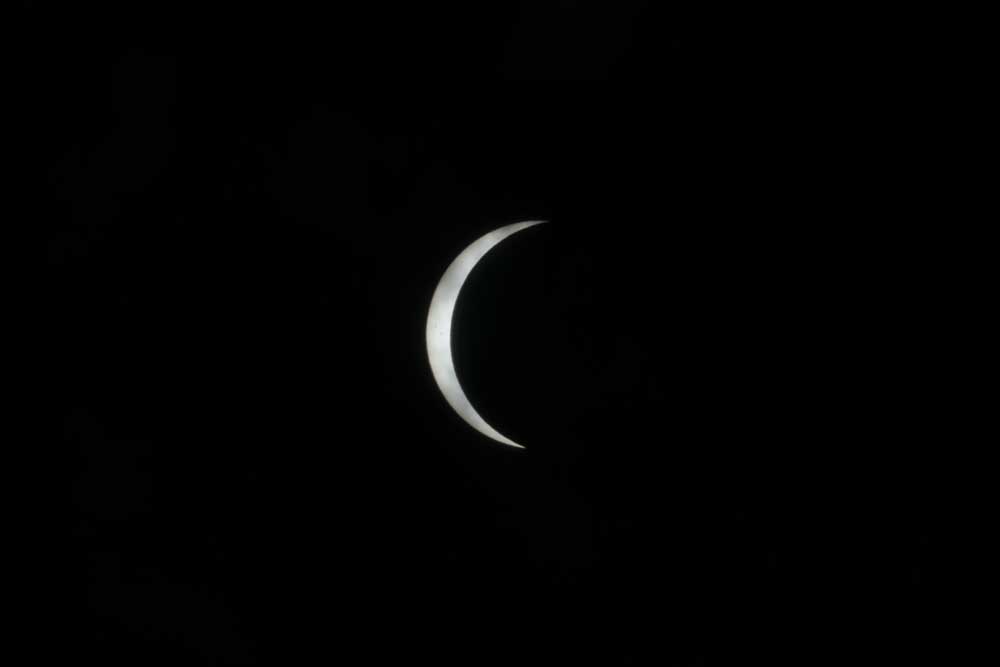Not for web
Published 9:00 pm Tuesday, April 2, 2024

- A partial eclipse in 2017.
Returning to Wooster, my hometown of 27,000 people in northeastern Ohio, is usually an occasion not to worry about street parking or dinner reservations. But on April 8 — thanks to the region’s position in the path of the total solar eclipse — I’ll be among the throngs of out-of-towners donning funky glasses to watch the sun disappear behind the moon’s shadow and experience eerie darkness at 3:15 in the afternoon.
For the small towns from Texas to Maine in the path of totality, next week’s celestial event will be their moment in the sun, while also out of it. One Texas judge has already declared a state of emergency in anticipation of Bell County’s population of about 400,000 doubling or tripling in the days leading up to the eclipse. Three school districts in the county have called off classes for the day. And if past is precedent, it’s not just humans who will behave strangely: As Carolyn Y. Johnson recently reported in The Post, we could see swarms of fireflies alighting during the day or giraffes spontaneously galloping around their zoo exhibits.
Maybe you don’t plan to be among the solar pilgrims battling highway gridlock next week. Maybe you are wondering if people have lost their minds. Why all the fuss about a predictable alignment of the Earth, moon and sun? Aren’t there more pressing concerns with a pending presidential election, war in Ukraine, famine in Gaza and climate crisis?
Here’s a reason to give in, at least a little, to eclipse-mania.
A few years ago, I traveled with my mother to the very southern tip of India, a place called Kanyakumari, where the waters of the Bay of Bengal, the Arabian Sea and the Indian Ocean meet. We stood before dawn among thousands of people dressed in red — pilgrims who had traveled far, some without shoes and some for hundreds of miles, simply to watch the sun break into the sky from that spot. As it rose, the crowd gasped, cheered, cried and clapped. Their reaction was as beautiful as the sunrise itself. I felt more connected to humanity than I have ever felt before or since.
What occurred to me in that moment is that the sun is the original rock star, the OG with main-character energy on Earth. Watching it rise and set, or more dramatically be eclipsed and then reemerge, is miraculous in part because it reminds us that the sun makes all life on the planet possible. The effect is naturally more profound when witnessed in an exceptional place or circumstance.
Post-pandemic, many of us feel less a part of our communities. In a polarized country and a war-struck world, we lack common cause. Amid this disconnection and alienation, a solar eclipse is an opportunity not only for awe, wonder and escape — but for binding ourselves to the past and future of humanity.
People have been looking up to the stars for answers for millennia, whether it was to know the will of their gods or to navigate their ships across unknown seas. The solar eclipse carried omens for the ancient Mayans and the ancient Greeks. We can only imagine what it might mean to our descendants in the future, or to the artificial intelligence overlords that might govern them. What we do know is that total eclipses will recur for the next half-billion years, and that as long as people inhabit Earth, these events will be a spectacle if only for their rarity.
Total solar eclipses happen about once every year to three years, but most are visible only from the poles or the middle of the ocean. From any specific location, they can be seen just about once every four centuries. They are one thing about the foreseeable future that, despite the dramatic technological and planetary changes ahead, will remain consistent with our past.
This is why a trip to see the eclipse will be a trip home even for those not raised in the path of this year’s totality. It will be a chance to be reminded of our place in the solar system and the cosmos — something that, no matter how stark our differences, we still share.





